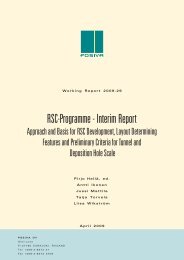Bentonite Mineralogy Part 1: Methods of Investigation - Posiva
Bentonite Mineralogy Part 1: Methods of Investigation - Posiva
Bentonite Mineralogy Part 1: Methods of Investigation - Posiva
Create successful ePaper yourself
Turn your PDF publications into a flip-book with our unique Google optimized e-Paper software.
32<br />
001 peak is sensitive to the relative humidity in the laboratory during the X-ray runs<br />
because the humidity affects the number <strong>of</strong> water layers in the interlayer position.<br />
During the runs the relative humidity was monitored and it ranged from 55 to 60%.<br />
6.1.2 Fractionation, saturation and preparation <strong>of</strong> oriented aggregates<br />
Fractionation was done by suspending gently ground samples in deionized water and<br />
letting them settle for 16-20 hours in 100 - 150 ml decanter glasses. No dispersing<br />
agents were used to avoid the exchange <strong>of</strong> interlayer cations <strong>of</strong> smectite minerals. The<br />
aim was to separate fraction< 1 J..Lm. Only couple <strong>of</strong> samples (Kutch 8939, Kutch 8940,<br />
Friedland, Skalna, Dnesice) could be fractionated like that. Three samples, all Ca,Mgmontmorillonites<br />
(Milos high-grade, Rokle, Strance) settled quickly and had to be<br />
washed free <strong>of</strong> electrolytes before fractionation. Most Na-montmorillonites formed gellike<br />
suspension. A small part <strong>of</strong> the gel from the top layer was mixed with deionized<br />
water and centrifuged (1 0 min, 2000 r/min). The uppermost part <strong>of</strong> clay was used for<br />
the preparation <strong>of</strong> oriented aggregates that were done by spreading the gel on a glass<br />
slide and letting it dry at room temperature. The gel from the decanter glasses was dried<br />
for further use (FTIR and TEM). The exact grain size is unknown. <strong>Part</strong> <strong>of</strong> the fraction<<br />
1 J..Lm, when possible to separate it, was used for oriented aggregates that were prepared<br />
using the filter transfer method (see 3.1.1). The rest <strong>of</strong> the fraction was centrifuged and<br />
dried for further use (FTIR and TEM).<br />
Two samples (Rokle & Strance) were saturated with Mg by mixing the bulk samples<br />
with 2M MgCh and letting the mixture stay for 24 hours. After that they were washed<br />
with deionized water by repeated centrifugations until the fine fraction remained in<br />
suspension. The suspensions were fractionated and oriented aggregates were prepared<br />
as described above.<br />
The X-ray diffractograms <strong>of</strong> the air-dried oriented aggregates were recorded from 2 to<br />
30°28. The counting time was 1 s per 0,02°28.<br />
6.1.3 Solvation with ethylene glycol (EG) or glycerol (G)<br />
After recording the diffractograms <strong>of</strong> air-dried aggregates they were placed in ethylene<br />
glycol atmosphere at 60°C for 16-20 hours. The X-ray diffractograms were recorded<br />
again from 2 to 30°20. Two oriented aggregates <strong>of</strong> Mg-saturated fine fractions were<br />
solvated also with glycerol by mixing three drops <strong>of</strong> glycerol to the suspension in the<br />
last phase <strong>of</strong> filtration. The oriented aggregate on the membrane filter was laid face<br />
down on a glass slide and the filter removed carefully. The diffractograms were<br />
recorded when the aggregates still were wet.<br />
6.1.4 Calculation <strong>of</strong> 1/S content<br />
The content <strong>of</strong> illitic layers in possible mixed-layer illite/smectite was estimated using<br />
the method suggested by Moore & Reynolds (1997); see 3.1.5).

















